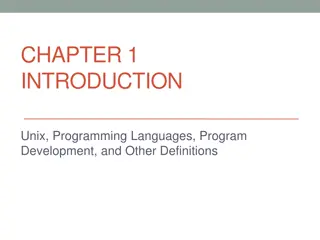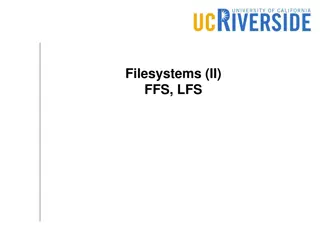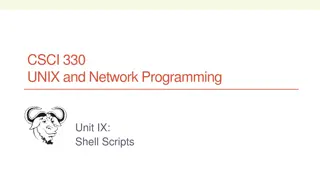Process Management in UNIX Systems
"Explore the intricate process management mechanisms in UNIX operating systems, covering the suspension, activation, and destruction of processes along with resource allocation and priority handling. Delve into the scheduling intricacies of UNIX environments for optimal performance."
Download Presentation

Please find below an Image/Link to download the presentation.
The content on the website is provided AS IS for your information and personal use only. It may not be sold, licensed, or shared on other websites without obtaining consent from the author.If you encounter any issues during the download, it is possible that the publisher has removed the file from their server.
You are allowed to download the files provided on this website for personal or commercial use, subject to the condition that they are used lawfully. All files are the property of their respective owners.
The content on the website is provided AS IS for your information and personal use only. It may not be sold, licensed, or shared on other websites without obtaining consent from the author.
E N D
Presentation Transcript
resources must be a subset of parents and be assigned as shared Initial priority of the process can be greater than the parent s
How processes are managed after creation in UNIX
1. Suspend - Change process state to suspended A process may suspend only its descendants May include cascaded suspension Stop the process if the process is in running state and save the state of the processor in the process control block If process is already in blocked state, then leave it blocked, else change its state to ready state If need be, call the scheduler to schedule the processor to some other process
2. Activate - Change process state to active Change one of the descendant processes to ready state Add the process to the ready list
3. Destroy - Remove one or more processes Cascaded destruction Only descendant processes may be destroyed If the process to be killed" is running, stop its execution Free all the resources currently allocated to the process Remove the process control block associated with the killed process Change priority - Set a new priority for the process Change the priority in the process control block Move the process to a different queue to reflect the new priority
3.4.2 Scheduling in UNIX
Scheduler decides the process to run first by using a scheduling algorithm
Pre-emptibility 3.6 Security
where the security mechanisms and policies should be implemented. Kernel security mechanisms play a critical role in supporting security at higher levels.
(adding features such as cryptography mechanisms where necessary), delegating some responsibility to the compiler. Approaches that delegate enforcement of security policy to the compiler and/or the application level are often called language-based security.























